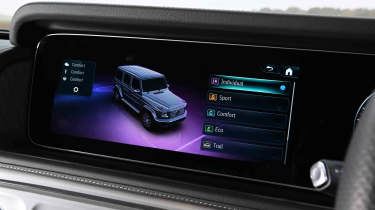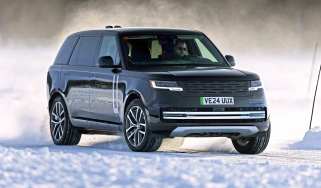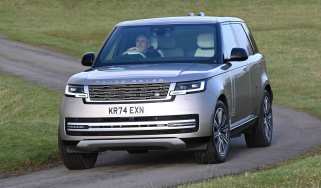Mercedes G-Class review
Mercedes' motoring icon is better than ever in its latest guise, but prices aren't cheap

Is the Mercedes G-Class a good car?
We understand the emotional appeal of the Mercedes G-Class, but for years it has been a car that is far more about its image than day-to-day usability. A mild-hybrid powertrain – no matter how slick – and a great infotainment system don’t change that much. The G-Class is a niche purchase in the UK, and most will be found parked on the trendy streets of central London. But exclusivity is guaranteed with the G-Class, and you’ll turn as many heads as in a supercar.
If we had the money, we’d go the whole hog and have the Mercedes-AMG G 63, or if that seems too uncouth, then the all-electric model is another alternative. If you want a posh 4x4 that drives well, get a Range Rover or Bentley Bentayga instead.
| Key specs | |
| Fuel type | Petrol, diesel, electric |
| Body style | 5dr large SUV |
| Powertrain | 3.0-litre, 6cyl turbocharged diesel, four-wheel drive 3.0-litre, 6cyl turbocharged petrol, four-wheel drive 4.0-litre, 8cyl turbocharged petrol, four-wheel drive 116kWh battery, 4x e-motors, four-wheel drive |
| Safety | 5-star (Euro NCAP, 2019) |
| Warranty | 3yrs/unlimited mileage |
How much does the Mercedes G-Class cost?
There are few cars which have gone through such a transformation of purpose as the Mercedes G-Glass. Initially a rough-and-ready vehicle designed for the military back in the 1970s, Mercedes has transformed it into a tough yet luxurious, old-school yet unapologetically brash SUV with a near £137,000 starting price that’s become a status symbol like few other cars. Love it or loathe it, what cannot be denied is that it has become one of the greatest hits from a brand whose history isn’t exactly short of commercial success.
Used - available now

2024 Mercedes
G Class
47,000 milesAutomaticPetrol4.0L
Cash £159,995
2024 Mercedes
G Class
40,510 milesAutomaticPetrol4.0L
Cash £129,000
2017 Mercedes
G Class
66,000 milesAutomaticPetrol5.5L
Cash £69,990
2024 Mercedes
G Class
3,111 milesAutomaticDiesel2.9L
Cash £121,990Key to this is that even though it still fundamentally looks very similar to the car that first carried the name more than 45 years ago, there’s now a whole lot more complexity under the skin. The latest round of updates has introduced mild-hybrid technology to all petrol and diesel engines, an all-electric variant, along with a host of subtle, but profound, changes.
Despite being updated to be more fuel efficient, the V8 engine in the Mercedes-AMG G 63 is still the most fun version in the G-Class range. However, there’s still a place for the diesel-powered G 450 d in a heavy off-road vehicle, especially if you intend to use it as more than just an urban runaround. If you are planning on posing around Chelsea and other fashionable London haunts, then either the G 500 petrol or all-electric G 580 with EQ Technology (we’ll refer to it as the G 580 from now on) should fit the bill. Whichever version you go for, exclusivity is guaranteed with this German icon.
Few vehicles for sale can reach the dizzy heights of legendary status – Mini, Beetle, Defender and Mustang are four names that spring to mind – but the Mercedes G-Class (formerly the G-Wagen) can pull up a chair at the top table of motoring icons. It has become a 4x4 of choice for the rich and famous, with Mercedes all too happy to cultivate some Hollywood glamour.
Much like the Land Rover Defender and Jeep Wrangler, the G-Class developed a loyal following, despite – how can we put this – not being the most mechanically sorted and refined of vehicles. It has been kept relatively fresh courtesy of a series of small changes, but an update in 2018 provided the most comprehensive overhaul that this model has ever gone through.
It was pretty much a complete redesign, cleverly retaining the iconic shape, but all body panels were changed in some way, and it was made bigger to make it more practical to better compete with its fellow large SUV rivals. The spare wheel on the back, the exposed door hinges and round headlights are three of the most visible nods to the G’s heritage.
Both the G 450 d and G 500 come in AMG Line Premium Plus trim, which is extremely well specified, with 20-inch alloy wheels, adaptive LED headlights, an augmented-reality sat-nav, Nappa leather and a heated windscreen to name but a few of its features. The standalone electric G 580 comes similarly well equipped, but has a few unique off-road driving settings, such as a G Turn, which allows the car to turn within its own length on loose surfaces, much like a tank can.
The high-performance Mercedes-AMG G 63 is available in four different trim levels. In standard form, it has everything the regular G-Class comes with, but with 22-inch AMG-specific alloy wheels, an AMG bodykit plus AMG styling details inside. Opting for the Carbon Edition adds more black and carbon-fibre exterior styling details. The Manufaktur Edition has some special paint options, a heated steering wheel, an extended leather package for the interior and ventilated front seats. The top-of-the-range Magno Edition builds on the Manufaktur Edition by including more black and carbon-fibre trim both inside and out.
Engines, performance & drive
Obviously, the Mercedes G-Class is still awesome to drive off-road. The clientele may have changed, but any G-Class has to be able to tackle the roughest of roads and the toughest of challenges. There are three differential locks, a set of low-range gears for off-roading, and a G-Mode, which allows the car to creep slowly but steadily over rough ground. There’s also an additional 10cm of wading depth – now up to 70cm – when driving through water or mud. Some concessions to modernity have had to be made, though. Owing to tweaks to the internal friction of the engine line-up, Mercedes has added hill-descent control to the G-Class, because the engine braking in low range is reduced over the outgoing model.
Improvements have been made to the refinement of the G-Class while driving on the road, making it easier to live with than its predecessor. A nine-speed automatic transmission delivers smooth up and downshifts when left to its own devices, but some extra control is available via the weighty paddle shifts mounted behind the steering wheel.
This isn’t the sort of car you’d want to start pushing on a country road, though, because it doesn’t handle anywhere near as sharply as some of the best large SUVs around.
| Model | Power | 0-62mph | Top speed |
| G-Class G 500 | 443bhp | 5.4 seconds | 130mph |
| Mercedes-AMG G 63 4MATIC | 577bhp | 4.4 seconds | 137mph (149mph with AMG Driver’s pack) |
| G-Class G 450 d | 362bhp | 5.8 seconds | 130mph |
| G-Class G 580 with EQ technology | 579bhp | 4.7 seconds | 112mph |
What is the Mercedes G-Class like to drive?
In town
Even though the G-Class was originally designed to conquer harsh and inhospitable environments far from the beaten path, modern customers have taken to using the Mercedes as a status symbol in busy towns and cities.
In fairness to the G-Class, its commanding driving position provides a great view over other traffic, while its square bonnet and chunky indicators make judging the car’s forward extremities fairly easy. You’ll still rely on the standard-fit 360-degree camera system when slotting into a space, because it has some chunky wheelarch extensions that stick out of the sides, and the spare tyre on the tailgate can cause issues when parking.
Speaking of parking, the G-Class isn’t the easiest vehicle to manoeuvre in tight spaces due to its size and huge 13.6-metre turning circle.
On A and B-roads
Using all the G-Class’s new-found performance needs plenty of forward planning when you’ve escaped the urban jungle, because things become a little more tense when you approach a corner. With so much mass to stop and turn, braking and cornering are two areas in which the Mercedes does not excel – its old-school construction means that even beside similarly vast SUVs, it’s still on the ponderous side.
The steering is nowhere near as sloppy as the Ineos Grenadier, but it’s slow and vague compared with the set-up you’ll find in a Range Rover, so a considered approach is required. The stability control’s tight-fisted grip on proceedings will be welcome to drivers who get a bit too carried away.
The sluggish handling doesn’t bring a benefit in comfort, either. A Range Rover, a Land Rover Defender or a Bentley Bentayga are all much more comfortable places to spend time behind the wheel.
On the motorway
On a motorway journey, the aerodynamic improvements of the G-Class, along with new insulation materials used in the A-pillars and elsewhere, have resulted in “increased acoustic comfort”, according to Mercedes. There’s no getting away from that chunky shape, though, so wind noise is still fairly pronounced at 70mph.
0-62mph acceleration and top speed
The top-of-the-range G 63 is powered by a fabulous 4.0-litre twin-turbocharged engine, which develops 577bhp and 850Nm of torque to create one of the most unlikely performance vehicles of the modern age. This is a little like strapping a pair of rockets to your favourite upmarket farm shop, with the 0-62mph time polished off in a ridiculous 4.4 seconds and a top speed of 137mph - although this can be increased to 149mph if you fit the optional AMG Driver’s pack. But while the speed is impressive, it’s the sound coming out of the side exhausts that’ll live longest in the memory.
In comparison, the 362bhp 3.0-litre straight-six diesel in the G 450 d is a more cultured and civilised affair, but it’s certainly no slouch. It’ll sprint from 0-62mph in 5.8 seconds before hitting a top speed of 130mph. As with the G 500 petrol, the G 450 d includes mild-hybrid technology, which uses a 48-volt integrated starter generator system that allows the engine to switch on and off seamlessly when stopping and moving away, while offering an extra 20bhp electrical boost to improve responsiveness.
The G 500 petrol uses a 3.0-litre straight-six turbocharged petrol engine, which, combined with the e-motor, puts out 443bhp and 560Nm of torque. Those are big numbers, so despite having to move around a 2,665kg kerbweight, the G 500 will still deliver acceleration that can surprise many hot hatchback drivers. The engine is fantastic; smooth and peaceful in everyday driving, yet even quite tuneful when you want to extend its legs.
Meanwhile, the fully electric G 580 EQ achieves the 0-62mph benchmark sprint 0.7 seconds quicker than the G 500, at 4.7 seconds, and has a top speed of 112mph.
MPG, emissions & running costs
Life with a Mercedes G-Class is expensive even before you’ve left the showroom, so the running costs are unlikely to come as a shock. Even with all petrol and diesel engines gaining mild-hybrid technology to boost fuel economy, the G-Class still feels like a bit of a dinosaur. A loveable dinosaur, but a prehistoric one all the same.
The G 450 d starts from a not insignificant £137,000, but the G 500 comes in at £146,000, and the G 63 weighs in close to £184,500. And the costs won’t stop there.
In the G 450 d, its mild-hybrid tech has boosted fuel economy up to 31.4mpg, but both petrol versions are significantly more thirsty. The G 500 has a combined figure of 25mpg, although we saw close to 30 mpg from it on a gentle motorway run. The G 63 is undoubtedly the thirstiest model in the G-Class range, with an economy figure of just 19.1mpg – or worse if you enjoy yourself.
No version of the G-Class is what you’d call efficient, but the G-Class wasn’t built with efficiency or aerodynamics in mind. However, some tweaks to its shape, including a spoiler above the windscreen, a redesigned A-pillar, and a lip spoiler below the bumper have reduced its drag coefficient from a pre-facelift figure of 0.53Cd down to 0.48Cd.
| Model | MPG | CO2 | Insurance group |
| G-Class G 500 | 25.0mpg | 257g/km | 50P |
| Mercedes-AMG G 63 4MATIC | 19.1mpg | 338g/km | 50P |
| G-Class G 450d | 31.4mpg | 235g/km | 50P |
Electric range, battery life and charge time
The latest G-Class has joined the world of electric vehicles with the G 580 with EQ technology. That’s quite a lengthy name.
Also big is its battery pack that, at 116kWh of usable capacity, affords a range of 280 miles between charges. It can accept a peak charging speed of 200kW, allowing for a 10 to 80 per cent top-up charge in around 32 minutes from a suitably rapid DC charger.
Most EV owners will likely utilise much more affordable home charging, of which Mercedes only quotes an 11kW AC time of around 12 hours to fully top up a G 580 from flat to full. However, that would require a three-phase electricity supply, which few UK houses can accommodate, so we anticipate that a more common 7.4kW home wallbox charger will take around 16 hours to recharge the car.
| Model | Battery size | Range | Insurance group |
| G-Class G 580 with EQ technology | 116kWh (useable) | 280 miles | 50P |
Tax
High CO2 emissions make the G-Class tax inefficient for private and company-car users, the latter of which will be stuck in the highest 37 per cent Benefit-in-Kind (BiK) tax band – although we’re unsure whether any company-car scheme would offer such a model to its employees.
The electric G 580 would be in a much more affordable two per cent band (rising to three per cent for the 25/26 tax year), but again, we doubt a company-car scheme would offer a near-£155,000 EV to staff.
Insurance groups
Make sure you’re sitting down when you use a price-comparison site to sort insurance quotes for the G-Class, because the cost will likely be very high. All versions are in the highest insurance group of 50, placing the G-Class alongside supercars and other luxury cars.
Depreciation
Depreciation is unlikely to bother a G-Class owner, because sales in the UK are modest, and it has a cult status, so its residual values are quite high. Most versions are in the region of 60 per cent, making the G-Class one of the best performers on the market. The Mercedes-AMG G 63 Carbon Edition is expected to hold on to 68 per cent of its original value after three years or 36,000 miles, according to our expert data. The electric G 580 with EQ technology is the worst-performing version, at 58 per cent, but that’s still a lot better than most electric cars.
However, when a new car costs well north of £100,000 (nearer £200,000 in some cases), you will still lose a considerable sum of money in depreciation.
To get an accurate valuation for a specific model, check out our free car valuation tool...
Design, interior & technology
Meet the new boss, same as the old boss. When it comes to the design of the latest Mercedes G-Class, it’s a case of 'if it ain’t broke, don’t fix it'. The designers knew they had to tread carefully when updating an icon, and so kept the styling makeover to a minimum in order for the latest version to retain all the hallmarks of a G-Class.
From the distinctive door handles to the sound the door makes when it’s closed, the exposed spare wheel on the tailgate to the indicators atop the front wings, the current G-Class looks almost identical to the original.
Look closer, and you’ll spot a pair of LED headlights, narrower panel gaps, and wheelarches and bumpers that look integral to the car. It’s a more cohesive design – a successful evolution of a much-loved icon, much like what has been achieved with the Land Rover Defender.
As you’d expect from a car with a starting price close to £140,000, the level of specification is high, with 20-inch alloys, adaptive LED headlights, Nappa leather, 64-colour ambient interior lighting, heated front and rear seats, three-zone climate control, and a 360-degree camera system all fitted as standard.
The G 63 gains a chrome exterior styling package, an AMG cosmetic makeover, AMG ride control, AMG sports exhausts, privacy glass, AMG sports seats and illuminated door sill panels. The G 63 Manufaktur Edition gets a heated AMG performance steering wheel, an extended leather package and ventilated front seats. The most expensive Magno Edition features more black and carbon-fibre trim pieces on the exterior and interior.
Options include Night and AMG Night cosmetic packs, which give the G-Class a sportier look and in tune with the G’s Hollywood vibe, there are a choice of exterior and interior colours, some of which we think are more tasteful than others.
What is the Mercedes G-Class like inside?
Clamber on board (and remember to give the heavy doors a firm pull, because they need to be slammed to close properly), and you’ll see there’s been a big focus on bringing the G-Class’s tech bang up-to-date with the rest of the Mercedes family. The latest version of the MBUX system is displayed through a 12.3-inch touchscreen infotainment system, with digital dials appearing in front of the refreshed steering wheel.
The rest of the cabin includes some ‘Easter eggs’ from the car’s off-roading heritage, from the prominent buttons for the three differential locks in the middle of the dashboard, along with the passenger grab handle to steady themselves while traversing undulating terrain. It all combines to create an interior that manages to look delightfully old-fashioned, yet has all the modern features you’d expect of a luxury vehicle.
What is the interior quality like?
The level of quality inside the G-Class is almost unmatched in this segment to deliver a cabin that’s brimming with class and appeal. Mercedes could have got this so wrong, but thankfully, it didn’t.
However, the Bentley Bentayga offers an even greater level of customisation of real wood, metal and leather finishes, taking things another step beyond the G-Class.
Sat-nav, stereo and infotainment
The two 12.3-inch infotainment displays are familiar from other Mercedes models and look perfectly at home in the G-Class. They combine to create an ultra-wide display that brings this icon right up-to-date.
Apple CarPlay and Android Auto are fitted as standard, while a Burmester surround system is standard. This 590-watt audio set-up comprises 16 speakers, a 10-channel amplifier and acoustics tailored to the G-Class interior. It’s one of the best systems on the market.
Boot space, comfort & practicality
The old Mercedes G-Class was very much like the previous-generation Defender, because the size of the cabin didn’t really match the exterior dimensions. While there’s certainly more room in the latest G-Class, much as there is in the Land Rover Defender, it doesn’t offer the same amount of space as the other SUVs in the Mercedes range. Indeed, while the Mercedes GLE impresses us with its large cabin and third row of seats, the G-Class feels more intimate, and there’s no seven-seat option.
There are enough pockets and bins throughout the cabin, including a pair of removable cup-holders in the front, two in the rear, map pockets on the back of the front seats, an overhead sunglasses holder, and space for bottles in the door pockets.
| Dimensions | |
|---|---|
| Length | 4,825mm (4,624mm G 580, 4,873mm Mercedes-AMG G 63) |
| Width | 1,913mm (1,984mm Mercedes-AMG G 63, 2,187mm inc mirrors) |
| Height | 1,973mm (1,976mm Mercedes-AMG G 63, 1,986mm G 580) |
| Number of seats | 5 |
| Boot space | 640-2,010 litres (620-1,990 litres G 580) |
Dimensions and size
The G-Class measures 1,969mm in height, 1,984mm in width (2,187mm including the chunky door mirrors), and 4,873mm in length (including the spare wheel on the back). This makes it a little bit shorter than the standard-wheelbase Range Rover, but almost as wide (5,052mm length and 2,209mm wide including mirrors). The G-Class still towers over the Range Rover by 100mm.
How practical is the Mercedes G-Glass?
Seats & space in the front
Despite the latest G-Class being 121mm wider than before, its huge centre console restricts the space in the front for two adults, compared with more spacious large SUVs such as the latest Range Rover.
All versions have electric adjustment and memory settings for both the driver and front passenger seats.
Seats & space in the back
Rear legroom is best described as adequate, and the G-Class would be a tight squeeze for adults sitting three abreast in the back, so you’re better off treating this as a four-seater compared with more spacious rivals. At least there’s not much of a transmission tunnel to rob those in the back of foot space.
On the plus side, there’s a decent amount of headroom throughout the cabin, so you won’t need to remove your riding hat before driving home from the point-to-point.
Boot space
The boot can swallow 640 litres of luggage with the rear seats in their upright position, extending to 2,010 litres with the 60/40 split-folding bench folded down. In comparison, a Range Rover offers 1,093 litres with the seats up and 1,976 litres with them down.
While those are some decent numbers for an SUV, the access to the G-Class’s boot is significantly hampered by a narrow door opening, plus the rear arches rob the boot of valuable width. The spare wheel mounted to the side-hinged tailgate door makes it rather heavy to open, which becomes a big issue if you have to get into the boot when the car is parked on a gradient with the front facing downhill. You also have to hope nobody parks too close behind you, otherwise you can’t get into the back without first pulling the car forward in order for there to be enough space to open the tailgate.
Towing
Predictably, the G-Class is a formidable towing vehicle, with the G 450d, G 500, and G 63 offering a 3,500kg braked towing capacity. This places it alongside the likes of the Land Rover Discovery and Range Rover on the list of the best load-pullers – perfect for towing horseboxes, heavy equipment and, in the case of the G 63, a small petrol tanker!
The all-electric G 580 isn’t rated to tow, although given how much pulling around a trailer or caravan impacts the overall driving range, and the difficulties involved with the charging infrastructure when needing to top up on long trips, we don’t expect many buyers of the EV version will be too fussed about this.
Safety & reliability
The latest Mercedes G-Class was crash-tested by Euro NCAP back in 2019, which is surprising considering its niche status. We’re happy to report that it earned a five-star rating, thanks to its strong construction, so the G-Class holds up well in the event of an impact. Adult occupants should fare well, too, with a 90 per cent score in this category.
Indeed, safety is one aspect of the G-Class that is much improved over the old model, with the latest car benefiting from a host of safety and assistance systems, some of which are optional on the more everyday SUVs and saloons.
For example, the Assistance package comprises blind-spot assist and adaptive cruise control and would be an expensive option in other models. The G-Class also features active brake assist, multiple airbags, an i-Size child-seat attachment system for the outer rear seats, and the obvious traction benefits of four-wheel drive.
Mercedes finished a disappointing 25th out of a list of 32 car manufacturers in our 2024 Driver Power customer satisfaction survey, which is well below 14th-placed BMW or Land Rover, which came 10th.
| Key standard safety features | Euro NCAP safety ratings |
|
|
Warranty
While some volume car manufacturers offer five and seven-year warranties, the G-Class is covered by a three-year guarantee, but at least there’s no mileage restriction. In comparison, Audi restricts its three-year warranty to 60,000 miles, although BMW’s cover is the same as Mercedes’. Extended warranties are also available.
The battery pack in the G 580 is covered by a separate eight-year or 62,000-mile warranty, and guarantees that the battery capacity won’t drop below 70 per cent in that time period.
Servicing
Service and maintenance of the G-Class won’t be cheap, but you can spread the cost by paying for a service plan on a monthly basis. The cost depends on the engine version you go for, and the number of miles you cover annually. You can choose a plan that covers two services taken over two years, three services over three years, or four over four years.
All versions need to be serviced every 15,500 miles or 12 months, whichever comes first.
Mercedes G-Class alternatives
Some will say that there isn’t really an alternative to the Mercedes G-Class, and they do have a point. The only other ladder-framed 4x4 with impeccable off-road ability using an iconic nameplate is the Toyota Land Cruiser, and that doesn’t offer nearly the performance of the G-Class or its luxury image. The Land Rover Defender gets the closest to matching the overall driving experience of the G-Class, but it's nowhere near as exclusive.
However, alongside other super-luxury SUVs, such as the Bentley Bentayga and Range Rover, the old-fashioned construction of the G-Class becomes much more apparent. The set-square design of this Mercedes can’t offer the high-speed refinement of either rival, and the G-Class isn’t as practical to live with every day as the Range Rover. It’s also a lot more ponderous to drive than the Bentayga on the road, which is where someone spending a six-figure sum on a car is more likely to drive, rather than risk damaging it on an off-road excursion.
Frequently Asked Questions
If you love the looks and its image, nothing comes close to offering the road presence of a Mercedes G-Class. However, there are far better large SUVs out there to use every day, such as the Range Rover or Bentley Bentayga































